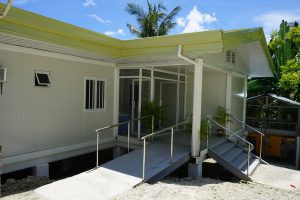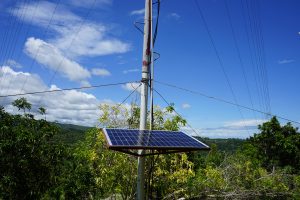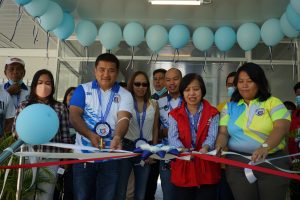The municipality of Boljoon, Cebu received four (4) sub-projects from DSWD’s Kapit-Bisig Laban sa Kahirapan Comprehensive and Integrated Delivery of Social Services (KALAHI-CIDSS), a result of the community’s participation and volunteerism in the 11 barangays of the town.

Two access roads in Brgy. Lower Becerril and Brgy. El Pardo, with a combined length of 0.974 km and a total cost of Php 4,021,000.00, and projects that respond to the pandemic such as handheld radios, a transmitter with a solar panel for information dissemination, and an isolation facility with medical supplies worth Php 12,265,000.00, were identified as their needs for development and targeted to benefit 4,196 households in Boljoon.
These completed sub-projects are funded under the National Community-Driven Development Program Additional Financing (NCDDP-AF) and Kapangyarihan at Kaunlaran sa Barangay (KKB), two modalities of the KALAHI-CIDSS that aim to develop poor communities by activating people’s empowerment and transformative participation.
Various people’s organizations and barangay committees were involved during the implementation of the program, including the town’s rural health unit that will soon take charge of the operationalization of one of the completed projects, the isolation facility.
During the height of the pandemic, communities in Boljoon struggled to respond to the rising number of cases in their locality because of their limited resources. Being a fifth-class municipality, they do not have the availability of facilities to cater to patients with highly contagious diseases.
Ramonito D. Fidellaga, SB member and chair of the committee on livelihood, expressed his gratitude on behalf of the town’s local chief executive. According to him, Boljoon is very fortunate to be endowed with projects that will augment their capacity to respond to health crises such as COVID-19, a need that was heard by KALAHI-CIDSS and implemented with the help of community volunteers.
“Ang turnover niining mga proyekto dinhi sa Boljoon dako jud kaayog tabang sa atoang katawhan. Gawas sa aduna na silay mahikap nga mga proyekto, mapahimuslan gyud kaayo ni nila kay mao ang ilang gi-ila nga panginahanglanon. Kini nagpamatuod nga adunay kalamboan sa atoang lungsod (The turnover of these projects here in Boljoon is a great help to our people. Aside from having tangible projects, they can also take advantage of and use these since they are their identified needs. This proves that there is truly a development in our town),” he added.

Even before the pandemic, this poverty reduction program of DSWD has responded to the needs of various communities in Boljoon. It has not only produced tangible products that people continue to take advantage of but improved the way Boljoanons think of government projects.
Raymond Bentazal, a former community volunteer and now the Association of Barangay Captains (ABC) President of Boljoon, recalled his experience with the KALAHI-CIDSS. “Daghan jud ang mga proyekto sa KALAHI-CIDSS nga sustainable. Sukad pa niadto diin gipaila ang programa dinhi sa Boljoon, nakita gyud nako nga adunay daghang mga proyekto nga hangtod karon napahimuslan pa gihapon sa katawhan dinhi sa among lungsod (Many of the KALAHI-CIDSS projects are sustainable. Ever since the program was introduced in Boljoon, I have seen that there are many projects that are still useful to the people in our town),” Bentazal said.
The isolation facility is a product of people’s unification to come up with a solution that will best respond to their needs. But these tangible projects are just byproducts. Through various participatory activities of KALAHI-CIDSS, volunteers were given the opportunity to identify solutions to their problems as well as develop their competencies to implement projects and prepare them to become leaders in the community.
Shermaine M. Codillero, volunteer and chairperson for the Procurement Team, shared how the program has given her realization as well as her appreciation for the community. “Akong naagian sa KALAHI nakadasig sa akoa og dako ug nakapuno sa akong kakugi sa adlaw-adlaw. Ningtaas ang akoang kompyansa sa akong kaugalinon ingon man ang kaalam sa pagpadagan og proyekto. Para kanako, kining pag-apil nako sa KALAHI-CIDSS, gamayng tampo aron matabang nako ang akong lungsod nga Boljoon (What I went through in KALAHI-CIDSS has inspired me and fueled my hard work. My confidence increased as well as my knowledge of working on a project. My participation in KALAHI-CIDSS is my small contribution to help my town, Boljoon),” Codillero said.
Through the prioritization of needs, communities, together with their local officials, are able to understand which of their unmet needs must be funded so that people can access these basic social services that hinder their development.

DSWD Field Office VII’s OIC-Division Chief for Promotive Services Emma F. Patalinghug expressed her gratitude to the people of Boljoon for embracing the KALAHI-CIDSS. “Nagbunga ang inyong panaghiusa nga makatagamtam og kaayohan dinhi sa inyong lungsod. Kini tungod sa inyong pagpili og mga proyekto nga angay nga motubag sa inyong panginahanglanon (Your unity has borne fruit so that your town can experience development. This is because of your decision to choose a project that will meet your needs),” she said.
Volunteers in Boljoon are witnesses to how KALAHI-CIDSS can transform a poor community into a progressive one through people participation and projects that lead to development. Through the projects turned over to them, they have felt the community development that they aim to achieve and they have learned to value the projects given to them since they are the ones who implemented it. ###